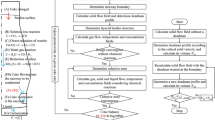Abstract
Increased utilization of natural gas in blast furnace ironmaking can decrease both the cost and the carbon intensity of ironmaking, given current US natural gas prices. In this paper, three ways to utilize natural gas are compared: tuyère injection, prereduction of iron ore, and shaft injection. The basis for comparison includes coke replacement ratios, carbon intensity and furnace productivity. These were calculated using relevant mass and energy balances, a blast furnace productivity correlation based on the bosh gas flow rate, and measured and modeled prereduction kinetics. Of the natural gas utilization methods, prereduction has the highest effective coke replacement ratio (and hence the largest advantage in raw material cost), but is likely to have the highest capital requirement.
Similar content being viewed by others
References
J.G. Peacey, W.G. Davenport, The Iron Blast Furnace, Theory and Practice (Pergamon, London, 1979)
US Energy Information Adminstration: http://www.eia.gov/electricity/state/unitedstates/; http://www.eia.gov/coal/production/quarterly/; https://www.eia.gov/naturalgas/. Last visited Sept 2016
2016 AIST North American Blast Furnace Roundup. Iron Steel Technol. 13(3), 256–259 (2016)
P. Bennett, T. Fukushima, Impact of PCI coal quality on blast furnace operations. in Proceedings of the 12th International Conference on Coal Science. Cairns, Australia (2003). Available at http://www.coaltech.com.au/LinkedDocuments/Bennett_Fukushima.pdf. Last visited Sept 2016
J.C. Agarwal et al., The use of total thermal-plus-chemical energy above 2700 °F as a parameter to describe blast furnace operations. Ironmaking Conf. Proc. 473–479 (1991)
J. Björkvall, D. Sichen, S. Seetharaman, Thermodynamic model calculations in multicomponent liquid silicate systems. Ironmaking Steelmaking 28, 250–257 (2001)
W.F. Castle, Air separation and liquefaction: recent developments and prospects for the beginning of the new millennium. Int. J. Refrig. 25, 158–172 (2002)
M.M. Fine, N.B. Melcher, Prereduced Iron ore Pellets: Preparation, Properties, Utilization. (Bureau of Mines, United States Department of the Interior, Bulletin 651, Washington, D.C., 1970)
J. Gibson, P.C. Pistorius, “Natural Gas in Ironmaking: On the Use of DRI and LRI in the Blast Furnace Process”, AISTech2015 Proceedings (Association for Iron and Steel Technology, Warrendale, Pa, 2015), pp. 657–671
R. Hunter, Massive savings in CO 2 generation by use of HBI (Third/Fourth Quarter, Direct from Midrex, 2009), pp. 9–11
M. Jampani, P.C. Pistorius, Increased use of natural gas in blast furnace ironmaking. Iron Steel Technol. 12(3), 37–43 (2015)
M. Jampani, P.C. Pistorius, “Increased use of natural gas in blast furnace ironmaking: methane reforming”, AISTech2016 Proceedings (Association for Iron and Steel Technology, Warrendale, Pa, 2016), pp. 573–580
J. Becerra, A. Martinis, Alternative energy sources, CO2 recovery technology and clean environment compliance—integral components of Energiron technology. Iron Steel Rev. 51(8), 107–110 (2008)
A. Rist, N. Meysson, A dual graphic representation of the blast-furnace mass and heat balances. J. Metals 19(4), 50–59 (1967)
M.F. Riley, Hot oxygen blast injection system, United States Patent number 6,090,182. 18 July 2000 (2000)
K.R. Muske et al., Advanced Control of Operations in the Blast Furnace Project. Phase One Effort Documentation: Optimal Operation and Control of the Blast Furnace Stoves (Technical Report LA-UR-99-5051, Los Alamos National Laboratory, 1999)
NUCOR 2013 annual report. Available at http://www.nucor.com/investor/performance/annual/. Last visited Sept 2016
Acknowledgements
Support of this project by the industrial members of the Center for Iron and Steelmaking Research is gratefully acknowledged.
Author information
Authors and Affiliations
Corresponding author
Editor information
Editors and Affiliations
Rights and permissions
Copyright information
© 2017 The Minerals, Metals & Materials Society
About this paper
Cite this paper
Pistorius, P.C., Gibson, J., Jampani, M. (2017). Natural Gas Utilization in Blast Furnace Ironmaking: Tuyère Injection, Shaft Injection and Prereduction. In: Wang, S., Free, M., Alam, S., Zhang, M., Taylor, P. (eds) Applications of Process Engineering Principles in Materials Processing, Energy and Environmental Technologies. The Minerals, Metals & Materials Series. Springer, Cham. https://doi.org/10.1007/978-3-319-51091-0_26
Download citation
DOI: https://doi.org/10.1007/978-3-319-51091-0_26
Published:
Publisher Name: Springer, Cham
Print ISBN: 978-3-319-51090-3
Online ISBN: 978-3-319-51091-0
eBook Packages: Chemistry and Materials ScienceChemistry and Material Science (R0)




